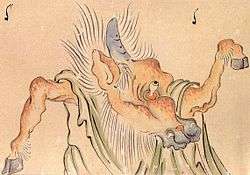
Bamboo
The bamboos ![]() i/bæmˈbuː/ are a subfamily (Bambusoideae) of flowering perennial evergreen plants in the grass family Poaceae.
i/bæmˈbuː/ are a subfamily (Bambusoideae) of flowering perennial evergreen plants in the grass family Poaceae.
Giant bamboos are the largest members of the grass family. In bamboo, the internodal regions of the stem are usually hollow and the vascular bundles in the cross section are scattered throughout the stem instead of in a cylindrical arrangement. The dicotyledonous woody xylem is also absent. The absence of secondary growth wood causes the stems of monocots, including the palms and large bamboos, to be columnar rather than tapering.
Bamboos are the fastest-growing plants in the world, due to a unique rhizome-dependent system. Certain species of bamboo can grow 91 cm (3 ft) within a 24-hour period, at a rate of almost 4 cm (1.5 in) an hour (a growth around 1 mm every 90 seconds, or one inch every 40 minutes). Bamboos are of notable economic and cultural significance in South Asia, Southeast Asia and East Asia, being used for building materials, as a food source, and as a versatile raw product. Bamboo has a higher compressive strength than wood, brick, or concrete and a tensile strength that rivals steel.
Bamboo (disambiguation)
Bamboo may refer to:
See also
Bamboo (film)
Bamboo (Spanish:Bambú) is a 1945 Spanish comedy film directed by José Luis Sáenz de Heredia and starring Imperio Argentina.
Cast
References
Bibliography
External links

Baka (word)
Baka (馬鹿, ばか, or バカ) means "fool; idiot", or (as an adjectival noun) "foolish" and is the most frequently used pejorative term in the Japanese language. This word baka has a long history, an uncertain etymology (possibly from Sanskrit or Classical Chinese), and linguistic complexities.
Word
The modern Japanese writing system transcribes the insult baka as バカ in katakana, ばか in hiragana, or 馬鹿 (lit. "horse deer") in ateji phonetic kanji transcription; earlier ateji renderings included 莫迦, 母嫁, 馬嫁, or 破家.
History
The first written usages of baka were during the Nanboku-chō period (1336–1392), when the "Northern and Southern Courts" battled.
In the earliest example, the Taiheiki historical epic records bakamono 馬鹿者 being used as an insult in 1342. The Ashikaga commander Toki Yoritō 土岐頼遠 refuses to pay obeisance to retired Emperor Kōgon (r. 1313-1364), "Yoritō, probably inebriated, loudly demands to know what kind of fool (bakamono) has the temerity to order him to dismount." According to Carr, "Shinmura found that the original editions (fourteenth century) of the Taiheiki had baka written バカ; [while] later movable-type editions (c. 1600) had the characters 馬鹿."

Baka people (Congo and South Sudan)
The Baka are an ethnic group from the Democratic Republic of the Congo and Western Equatoria in South Sudan. They are mainly Christian and number about 25,000 people (1993).
Baka (prince)
Baka is the name of an ancient Egyptian prince. He is known for his destroyed statuette. He is also subject of a theory that claims he was pharaoh of Egypt for a very short time. Thus, he might be identical to a scarcely known king named Bikheris.
Identity
Baka was a son and prince of pharaoh Djedefre. He lived and worked during the 4th dynasty. His private live is unknown, the names of his own family members are lost. Since the names of three other sons of Djedefre, namely Setka, Harnit and Nykau-Djedefre, are archaeologically detected, these should be Baka's brothers or halfbrothers. The daughters of Djedefre, Hetepheres III and Neferhetepes, would be Baka's sisters or half-sisters. His mother is unknown, too. It could be one of Djedefre's wives, Khentetka or Hetepheres II, but this is highly uncertain.
Possible reign as pharaoh
According to Rainer Stadelmann and George Reisner, it is possible, that Baka was pharaoh in Egypt for a very short time (maybe one or two years). Their assumption is based on the so-called Unfinished Northern Pyramid of Zawyet el'Aryan, which is located at Zawyet el'Aryan. This unfinished pyramid shaft was abandoned shortly after beginning and only a dozen of black ink workmen's inscriptions were found. These provide a royal cartouche name, which remains partially illegible. The first sign can be identified as a Ka-sign, but the first (and former) sign was copied by the pyramid excavator so fuzzy, that it remains undecipherable. According to Stadelmann and Reisner, the first sign shows a walking ram, as it does in the birth name of the prince. Baka simply put his citizen name into a royal cartouche due his lifetime, but then the name was changed after his death into Bakarê ("soul and Ka of Râ"). In ancient Greek chronics Baka's name was hellenized into Bikheris. For this reason, the unfinished tomb shaft at Zawyet el'Aryan is also called "Pyramid of Bikheris".
Podcasts:

